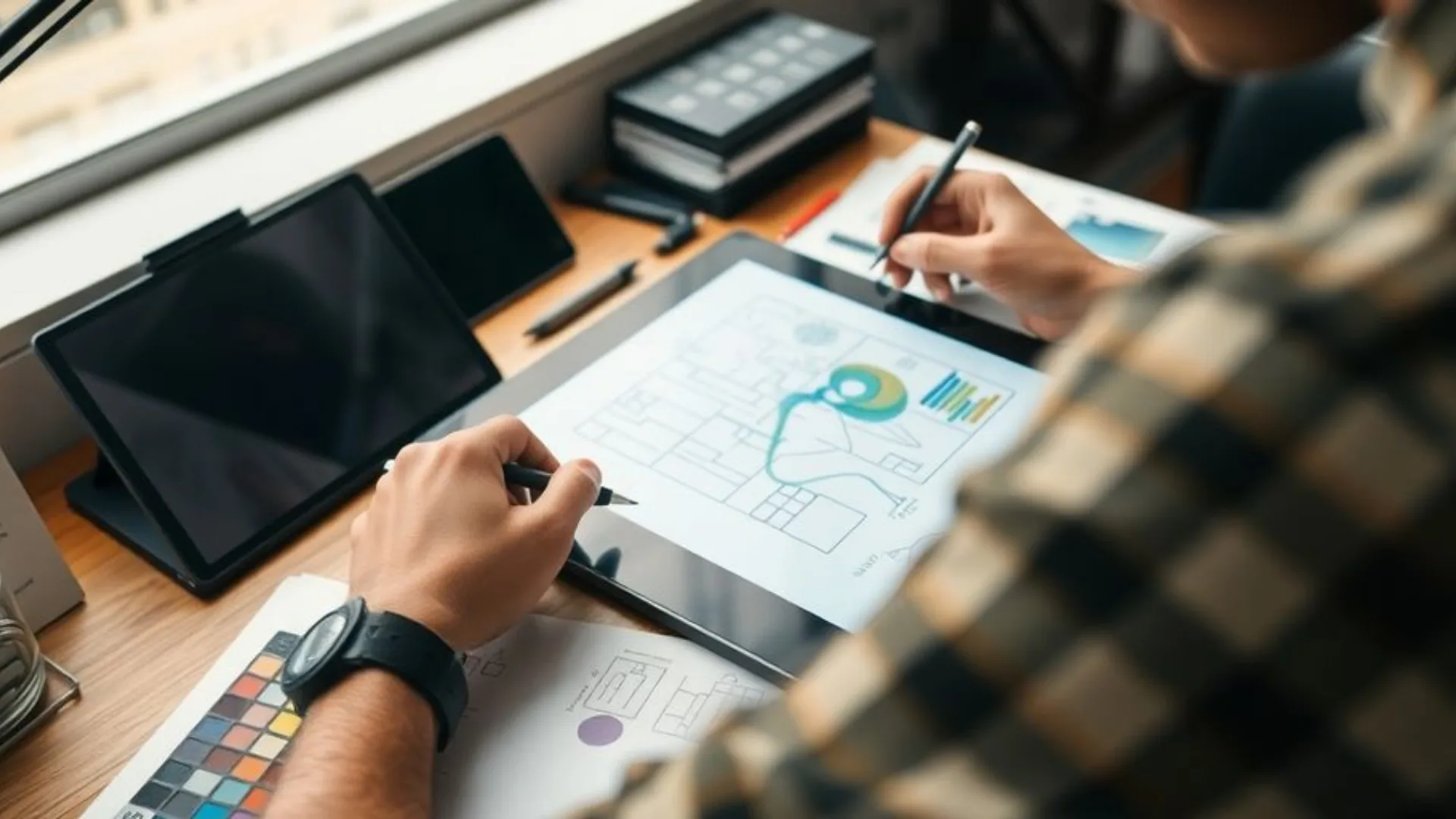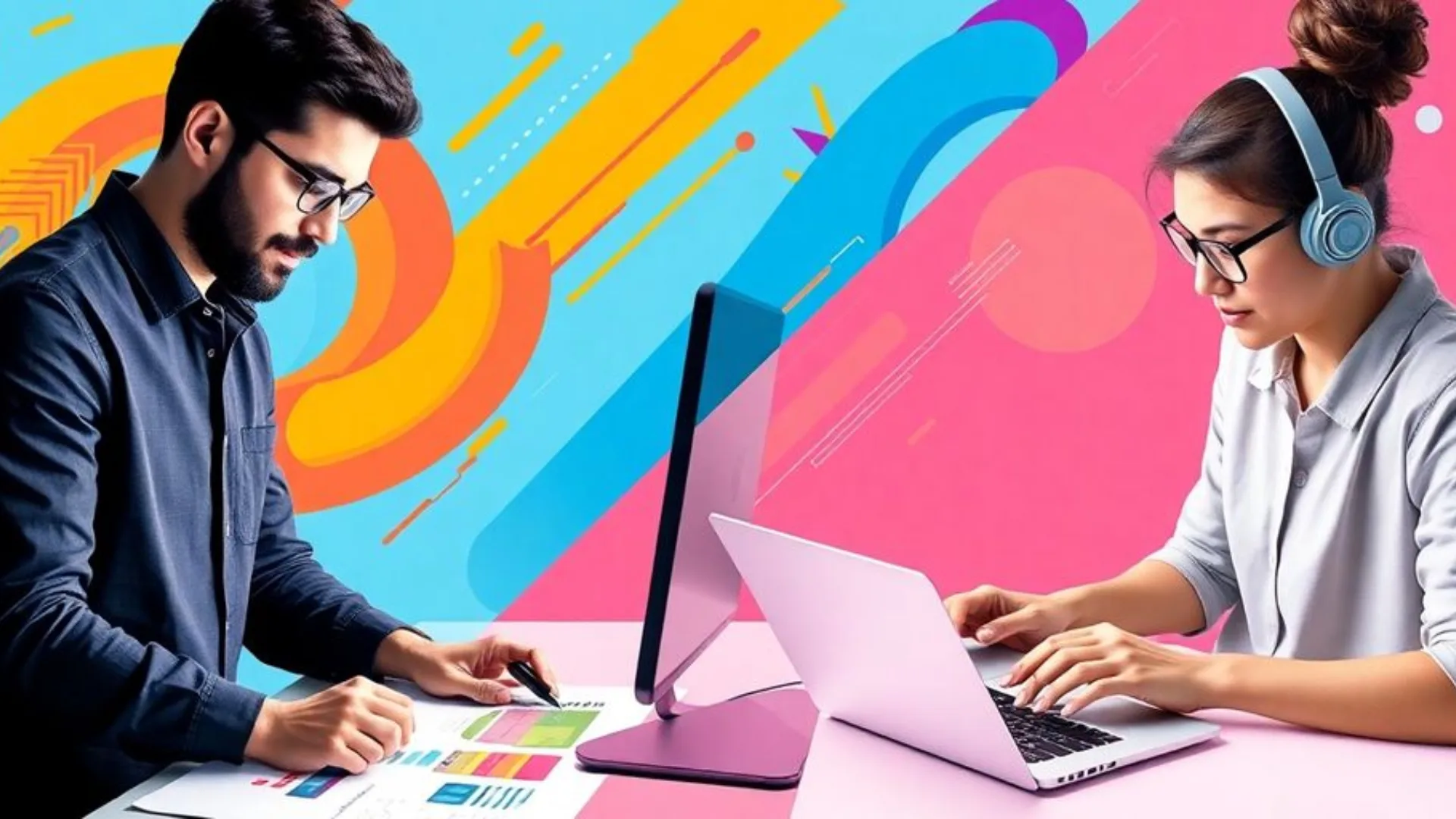So, What’s the Difference Between Graphic Designer vs Digital Designer? It’s a question that comes up frequently, especially when you’re at a crossroads about which direction to go or whom to hire for a project. Though there are some overlaps in terms of responsibilities between the roles, they offer distinct qualities and strengths. To give you clearer picture, in this article we’re laying out the differences graphic designer vs. digital designer.
- Graphic designers are more rigidly aligned with print material such as brochures and posters, and digital designers work with online content.
- Both roles call for creativity, but digital designers have to know at least a little bit about coding and web design.
- Typically graphic designers work in programs such as Adobe Illustrator and Photoshop, whilst digital designers may use Sketch or Figma.
- Career paths can vary — graphic designers may be used in advertising, while digital designers may be employed in tech companies.
- Knowing the difference will help you decide the best career or which professional to hire for your project.
Introduction Of Graphic Designer vs Digital Designer
It can be a bit confusing to know the difference between a graphic designer and a digital designer especially in the ever-changing world of design. Both positions are essential in the realm of design, but they aim to achieve different goals and you need different skills to excel at each. Graphic designers specialize in print and digital visual content, while digital designers tend to work with more interactive and user experience elements.
Graphic design dates back for decades and is traditionally based around print media such as magazines, posters, and advertising. The stereotypical image of a designer putting colors together is a myth. Digital design, in contrast, is a relatively young discipline, appearing with the advent of the internet and electronic devices. It covers everything from website layouts to app interfaces, and revolves around user interaction with digital spaces.
Understanding these roles is essential for anyone looking to pursue a career in design or hire a professional for a project. Knowing the difference can help you make informed decisions about what kind of designer you need.
A graphic designer, in its most basic concept, is someone who makes logos, brochures, branding materials and so on. They are the creators who make ideas a visual reality on paper and screen. Digital designers, on the other hand, are more like architects of the digital world. They create the interactive features that keep websites, apps, and digital platforms fun and intuitive.
In the sections that follow, we’ll dive deeper into the specific responsibilities and skills required for each role, and explore how they compare in terms of tools, software, and career opportunities. For a more detailed look at the key differences between graphic designers and web developers, continue reading to see how artistic visuals contrast with the technical aspects of website creation.
Defining Graphic Design

Graphic design is a creative field that involves using visual content to communicate messages. Graphic designers use the concepts of typography and image to meet specific needs of users by use visual hierarchy and page layouts, while also emphasizing the reasoning of item placement within their design of interactive designs, establishing the most effective user interface experience. Graphic design brings together art and technology to communicate ideas through typography, imagery, color and form.
Key Responsibilities of a Graphic Designer
There are many aspects of graphic designing depending on the type of design you do. Their primary responsibilities are as follows:
- Creating visual concepts for different projects including ads, brochures, magazines, and corporate reports.
- You are able to work with clients and stakeholders to understand requirements and objectives of a given project.
- Editing and creating designs with specialized graphic design software.
Graphic designers play a crucial role in shaping the visual identity of brands and products.
Skills Required for Graphic Designers
To excel in graphic design, professionals need a blend of technical and creative skills. Here are some essential skills:
- Creativity: The ability to think outside the box and come up with innovative design solutions.
- Typography: Understanding the art of arranging type to make written language legible, readable, and visually appealing.
- Proficiency in design software, such as Adobe Photoshop, Illustrator, and InDesign.
That is not all that graphic design is about, however; graphic design is also about problem solving and the effective communication of ideas. One thing though, no matter if you are working on a logo or a complex web layout, you always aim to communicate something clearly and beautifully.
Defining Digital Design
All content visual design for the screen. This extends to everything from websites and apps to digital ads and social media graphics. While traditional graphic design is static, digital design is interactive and dynamic. It is not merely how things look, but how they work.
Key Responsibilities of a Digital Designer
Digital designers wear many hats. Here are some of their main tasks:
- Designing user-friendly interfaces for websites and mobile apps.
- Creating engaging graphics for social media platforms.
- Working with developers to ensure designs are implemented correctly.
- Testing designs to make sure they work well on different devices.
- Updating and maintaining digital content.
Skills Required for Digital Designers
To excel in digital design, you need a mix of creative and technical skills:
- Creativity: Essential for coming up with innovative designs.
- Technical skills: Knowledge of design software like Adobe XD or Sketch.
- Understanding of HTML/CSS for better collaboration with developers.
- Ability to think from a user’s perspective to improve usability.
- Strong communication skills to work effectively in a team.
Digital design is more than just art on a screen; it’s about creating experiences that are both functional and aesthetically pleasing. It’s where creativity meets technology, making it a dynamic and exciting field to be part of.
Comparing Graphic Designer vs Digital Designer

Tools and Software Used Graphic Designer vs Digital Designer
Graphic designers and digital designers each have their favorite tools of the trade. You probably use tools (or types of tools) like Adobe Photoshop, Illustrator, and InDesign. They are excellent for creating print designs, logos, and other graphic content. Digital designers, on the other hand, may use tools like Sketch, Figma, or Adobe XD. These tools are designed specifically around UI and digital experiences.
Here’s a quick comparison of the tools:
| Graphic Design Tools | Digital Design Tools |
|---|---|
| Adobe Photoshop | Sketch |
| Adobe Illustrator | Figma |
| Adobe InDesign | Adobe XD |
Career Opportunities Of Graphic Designer vs Digital Designer
Graphic design and digital design are two distinct career paths. Advertising agencies, print media, and branding firms are common workplaces for graphic designers. Theirs are also more focused on static visuals. Digital designers tend to work in tech companies, creating websites, apps and interactive media.
- Graphic Design Careers:
- Digital Design Careers:
Choosing between graphic design and digital design depends on where your interests lie. If you love creating visual art for print, graphic design might be your thing. But if you’re more into interactive and digital experiences, then digital design could be the way to go. Both fields have their own unique challenges and rewards, so think about what excites you the most.
Conclusion of Graphic Designer vs Digital Designer
To finish our topic about the difference between graphic designer and digital designer, of course each role has its own flair and expertise in the creative world. Graphic design is inherently a very tangible medium, dealing with traditional print media and static images. On the other hand, it is the digital design that shines in the web world, where interactivity and dynamic content are a part of the game.
While tools and outputs may differ, fundamentally, both professions are rooted in creativity and communication. Graphic designers, on the other hand, might be doing logos and brochures — visually oriented layouts that help communicate a brand identity. But digital designers might also build interfaces for websites or interactive media that reach people digitally.
The lines between graphic and digital design can sometimes blur, but understanding their distinctions can help businesses and individuals choose the right professional for their needs.
If you are looking for career opportunities, you might want to ask yourself where your passion is. Do you relish the tactile quality of print and building graphics with small, fixed dimensions? Or are you thrilled about designing for screens and using technology to improve user experiences?
Ultimately, both paths offer rewarding careers, and the choice between them may come down to personal preference and the type of projects you wish to pursue. For more insights into how these roles differ and complement each other, you might want to explore the distinctions between graphic design and digital art.
So, there you have it. Graphic designer and digital designer sound alike, but they are actually complete different things. Graphic designers are basically visual magicians who know all the tricks of creating catchy posters, brochures, etc. for print and digital media. While digital designers are more focused on creating designs for digital experiences, like websites and mobile apps. Both roles are really important in their own way and frequently work together to make sure that everything looks and functions nicely. Whether you are considering hiring one or becoming one, it’s helpful to know what each role entails. That way, you will be able to choose the best approach for your project or career road. In the end, it’s all about creating beautiful stuff that Just Works.
Frequently Asked Questions
What is the main difference between graphic design and digital design?
Graphic design usually focuses on creating visuals for print media like brochures and posters. Digital design is about making designs for digital platforms like websites and apps.
Do graphic designers and digital designers use the same tools?
Not always. Graphic designers often use tools like Adobe Photoshop and Illustrator. Digital designers might use those plus others like Sketch or Figma for web and app design.
Can a graphic designer work as a digital designer?
Yes, a graphic designer can work as a digital designer, but they might need to learn new skills, especially related to digital tools and platforms.
What skills do you need to become a graphic designer?
To be a graphic designer, you need creativity, an eye for detail, and skills in design software like Adobe Photoshop and Illustrator.
What skills are important for a digital designer?
Digital designers need to know how to use design software like Sketch or Figma. They also need to understand how people use websites and apps.
Are there more job opportunities in graphic design or digital design?
There are many jobs in both fields, but digital design might have more opportunities because of the growing need for digital content.
